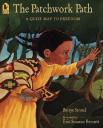The Patchwork Path is written by Bettye Stround and illustrated by Erin Susanna Bennett. The story is told by Hannah, a ten year old girl, who is a slave on a Georgia plantation. When the story begins, Hannah’s sister has been sold to another plantation and soon after that, her mother passes away. Before her mother died she taught Hannah how to make a special quilt. Each section of the quilt has a special meaning and gives directions to run to freedom. There is a code that goes along with the quilt to remember what each section means.
The monkey wrench
turns the wagon wheel
toward Canada on the bear’s paw trail to the crossroads.
Once they got to the crossroads,
they dug a log cabin on the ground.
Shoofly told them to dress up in cotton
and satin bow ties and go to the cathedral church, get married, and exchange double rings.
Flying geese stay on
the drunkard’s path and
follow the stars.
The monkey wrench is the quilt itself. One day in spring Hannah’s papa has her air out the quilt and that signals to the other slaves that they will be escaping tonight. The wagon wheel is Hannah’s papa because he is the wagon driver for the plantation so he knows all the roads, streams, and woods and knows where to hide while they are escaping. Hannah and her papa escape that night and run through the woods until they get to a church where they hide under the floor boards until it is safe for them to come out again. The next day they see a flock of geese flying North and they know they must follow the geese to get to freedom. On their journey they find bear paw marks and that leads them to a safe cave to sleep in for the night. They always walked in a zigzag pattern like a drunkard’s path because it would be harder for the Master’s dogs to catch their scent. The Shoofly pattern on the quilt reminded them that if anyone ever came after them they should scatter like flies and then meet up at the spot that they were separated. After a long journey Hannah and her papa finally make it to Lake Erie where they drew a log cabin in the sand to signal that they needed help to cross the lake into Canada. That night a free black man found their sign and brought them new clothes. The new clothes made Hannah and her papa look like they were already free and headed to church. That night they board a boat for Canada and sail into freedom. During their first winter of freedom Hannah makes a new quilt with scraps of their old slave clothing, sections of their other quilt, and new fabric too. Hannah leaves one section blank so that when her sister Mary is reunited with them, they can finish the quilt together.
Curriculum Connections
The Patchwork Path would be a great book to read after student’s have had some experience with maps and directions. It was recommended for grades K – 3, but I think that Kindergarten would be a little too young to use this book to illustrate using maps. It would be better to show how student’s could make a simple map of a familiar area, like their neighborhood or home town and for older students, including a title, legend and compass rose with their map (VA SOL 1.5, 2.6).
Additional Resources
- Students could use this coloring page as a map and then write a secret code about how to get to the “X”.
- This website has printable pages to make a “Where I Live” booklet.
- This website is an interactive map about the underground railroad. It has 3 different activities such as finding the shortest route for a person escaping from slavery in Georgia.
Book: The Patchwork Path
Author: Bettye Stroud
Illustrator: Erin Susanne Bennett
Publisher: Candlewick
Publication Date: 2005
Pages: 32 pages
Grade Range: K-3
ISBN-10: 0763624233

